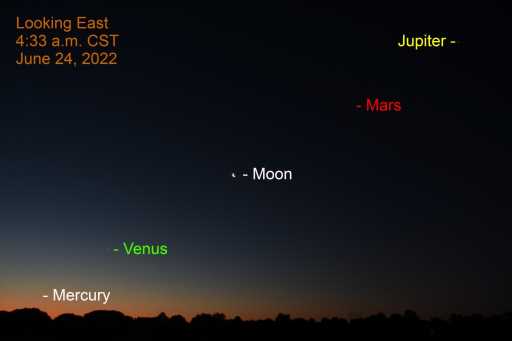Over the next five mornings in the pre-dawn hours, five planets could be visible in the eastern sky in a fairly rare planetary alignment.
As viewed from east to west, you should be able to see Mercury, Venus, Mars, Jupiter and Saturn, which is in the order of their distance from the sun, with Mercury being closest and Saturn being the furthest. Earth’s orbit is between Venus and Mars.
Some of the planets may require binoculars to locate, especially Mercury.
“Mars, Saturn and Mercury are the challenges,” said Jeff Hunt, a retired Illinois planetarium director whose website — whenthecurveslineup.com — tracks interesting celestial events for amateur sky-gazers. “The real challenge is Mercury.”
The problem isn’t Mercury’s size but its proximity to the sun. Because of that, pre-dawn twilight will render it invisible not long after it rises over the eastern horizon. If you want to see it, you’re going to need binoculars, Hunt said.
“Mercury is not easy to see, and it’s hard to photograph,” Hunt said. “It is somewhat bright, but it’s in bright twilight. If it were out there by itself where Mars is, in a dark sky, it would be much brighter than Mars and much brighter than Saturn. You have to have a good horizon (view). You have to be outside looking for it about 45 minutes before sunrise. Thirty minutes before the sunrise, the sky is way too bright.”
Sunrise on Sunday through Wednesday will occur shortly after 5:30 a.m.
The appearance of the moon in this alignment can help viewers locate the planets. On Sunday morning, the moon and Venus will appear in a “spectacular pairing,” Hunt said.
“Their closest pairing of the year, a really thin moon, bright Venus,” Hunt said. “The next day I think is important because the moon and Mercury will fit into the same binocular field, so if you can find the moon through the binocular, Mercury is going to be just to the lower right of it.”
Jupiter and Venus will be helpful in locating Mars. Venus and Jupiter will be the two brightest, star-like objects in the sky.
“Jupiter is up there in the southeast,” Hunt said. “Then, to the lower left of Jupiter is a dimmer-looking star. That’s Mars. Mars is roughly one-third of the way from Jupiter to Venus. Then, down in the south, about the same brightness as Mars is Saturn. Slightly lower than Jupiter but easily seen. It’s just not a real bright thing.”
The same five planets will be in alignment in April 2036, but not in the same order, and they will appear in the evening sky.
Subscribe to our weekly newsletter, The Adventurist, to get outdoors news sent straight to your inbox.
Source: Read Full Article
